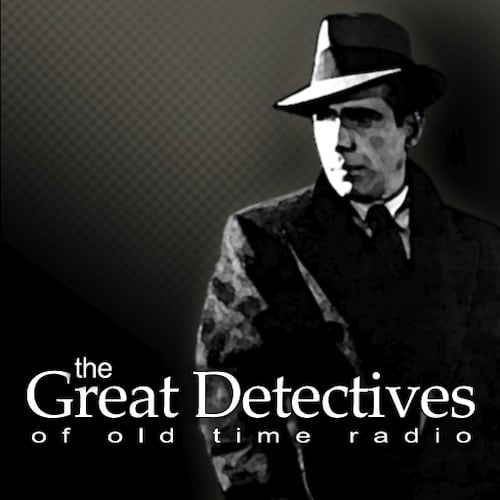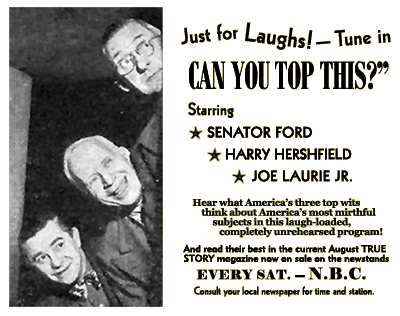We continue our march to 1000 episodes and our look back at our best shows.
In previous posts, we’ve examined our most exciting episodes, our most humorous, and our best mysteries.
This time we take a look at our most dramatically powerful episodes. Many of our shows are light entertainment, but some go to another level. Some are thought provoking, heart warming, or heart breaking. They’re stories that move us, inform us, and challenge us. They engage the mind and heart. They are brilliantly conceived and executed. Whittling this down to ten was challenge, but here’s my list:
10) Yours Truly Johnny Dollar: The Trans-pacific Export Matter
This script was the basis for both John Lund and Gerald Mohr’s auditions, but for my money no one did it better than Edmond O’Brien in 1950 who deals with tragedy when a beautiful young woman is murdered as a result of his investigation of an apparent insurance fraud.
9) The Abbotts: The Dead White Flame
The Abbotts are involved in a plane crash that sees a famous psychiatrist die. However, Pat suspects there’s more to this murder than meets the eye. And Pat and Jean get a peak at how dangerous this new post-war world is when they get Pat admitted to a sanitarium.
8) Barrie Craig:-A Time To Kill
Barrie finds a beautiful girl in his car, and someone is after her. She tells him one amazing whopper after another while at the same time, Barrie takes a beating from his pursuers. The episode at times seemed like one of his biggest oddball cases, yet the ending is one of Craig’s most moving and tragic.
7) Yours Truly Johnny Dollar: The Broderick Matter, Parts 1-2, 3-4, and 5
Johnny begins with a simple case that seems to have the making of a heart warming tale. A poor man who sold newspapers took out a $1500 on his life with the beneficiary a sweet 11 year-old girl who helped him sell his papers one day. He paid his policy faithfully and Johnny sets out to find her. He quickly runs into disillusionment as he learns that her life didn’t seem to justify the old man’s faith as she’s left behind a line of frauds, thefts, and spurned lovers. When he finally finds her, can he stop her from making the greatest mistake of all?
6) San Francisco Final
There are many unaired pilots that are in circulation among OTR fans. Some you know exactly why they weren’t picked up. Others just make you scratch your head. Such was the case with San Francisco Final. This pilot not only had star power in Jeff Chandler but a brilliantly written and acted first script that told the tale of Chinese American families hit by blackmail that drove them to crimes of violence and passion. Reporter Mike Rivera looks for the root of the problem. The solution is shocking and the denouement of the story is brilliantly done.
5) Box 13: The Treasure of Hang Li
Dan Holiday follows the instructions in a letter to purchase “the Hang Li” piece. The shop owner gives it to Holiday and insists he not pay for it. It’s a very surprising story, and perhaps the most profound of the series.
4) Frank Race: The Istanbul Adventure
Frank Race flirted with many women during the course of the series, however he fell hard for a woman named Lisel in this episode. She’s engaged in vital work as she’s trying to get medicine to suffering people in post-war Europe but they’re facing ruthless black marketeers who are selling weak and ineffective medicines that are spreading death and misery. The program brings home the pain and suffering the black market inflicts on the wold. The episode ends with a mix of tragedy and irony that makes the episode a true dramatic gem.
3) Yours Truly Johnny Dollar: The Valentine Matter, Parts 1 and 2, Parts 3 and 4, and Part 5.
Johnny has a chance encounter with an ex-boot legger who has retied from crime and chosen to live a quiet, simple life. However, someone’s determined not to allow him to. Assassins come after him with no known motive. He ends up meeting the daughter of the gangster: a lovely and unassuming young woman who didn’t know she was the daughter of the infamous Dan Valentine until he was shot down in cold blood. The story is a tragic one and it’s a powerful story because the impact of each death is felt, unlike many episodes where person X dies. The story explores the humanity of Johnny Dollar and is almost a meditation on the destructive power of hate and unforgiveness, as well as that there can be good even in some people who have done bad things.
2) Pat Novak for Hire: Little Jake Siegel
This episode is not technically complete. The sound quality isn’t great and the last few seconds of Novak’s closing monologue are missing. That said, what we have is an amazing story that’s groundbreaking. It’s a modern tradition, dating to perhaps the 1980s or 90s to have a powerful season finale and certainly series finale, that shakes the lead character’s world up. No one did this in 1949. Characters continue to be pretty much who they were regardless of what happened.
However, in the Summer of 1949, Pat Novak for Hire was headed off the air for the Summer, and because Jack Webb was forced to take up work on a new summer show called Dragnet, this would turn out to be Pat Novak’s last episode, and writer Richard Breen penned a very different story.
Novak visits a church at the request of a priest. A gunman enters and shoots a nine year old altar boy who died saving Novak’s life. Novak sets out to find out who the killer is. There’s less humor in this episode and Novak is believably more intense as he’s determined to square for things for Little Jake. At the end of the day, it seems unlikely that things could ever be the same again for our wisecracking waterfront hero. It’s a tour de force, and hopefully the whole episode will be available in a complete form some day, but even with its flaws, it remains an amazing story.
1) Sherlock Holmes: The Guileless Gypsy
Basil Rathbone was stuck with Sherlock Holmes, which could limit this talented star. However, Rathbone’s New Adventures of Sherlock Holmes provided many touches such as Rathbone performing other works as Holmes, or the use of music, or the show’s meticulous research on mysteries. All this came together in a beautiful package called The Guileless Gypsy. A powerful man asks Holmes to investigate and accuses a band of gypsies of threatening to kidnap his nephew, the heir to his brother’s fortune. Holmes visits the gypsy camp and strikes up a friendship with a beautiful gypsy woman. In one of the best radio scenes ever, they get acquainted and break through the ice with music. First Holmes plays what passes for gypsy music in London. Then she plays the real thing, and then the two violins play together in a beautiful and moving melody. There’s no romance in this story, but genuine affection. The story also had a timely yet timeless message about bigotry and inciting race hatred. In 1946, Americans no doubt would remember that Gypsies were a group singled out for persecution by the Nazis. This episode speaks to the common humanity and both Holmes and the girl, with a powerful twist in the plot. This episode features Basil Rathbone at his dramatic best in this series.
That concludes our series. I’d love to hear what your favorite episodes were. Let me know in the comments.
If you enjoyed this post, you can have new posts about Detective stories and the golden age of radio and television delivered automatically to your Kindle.

